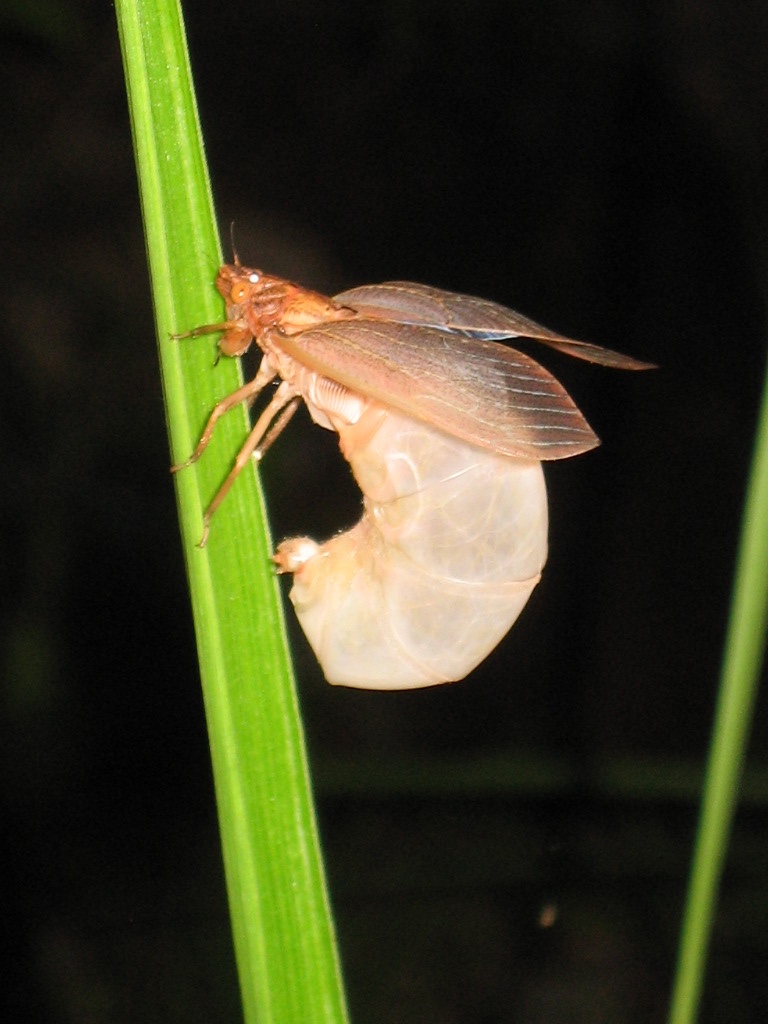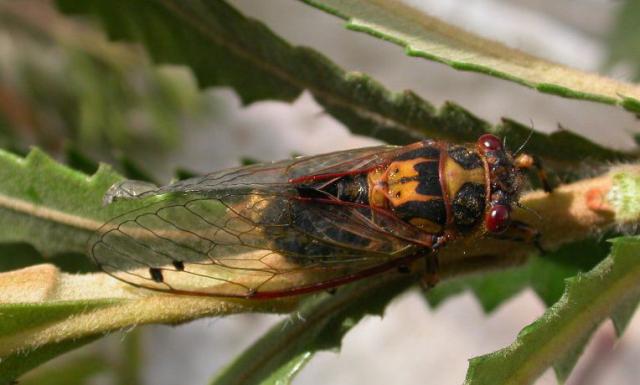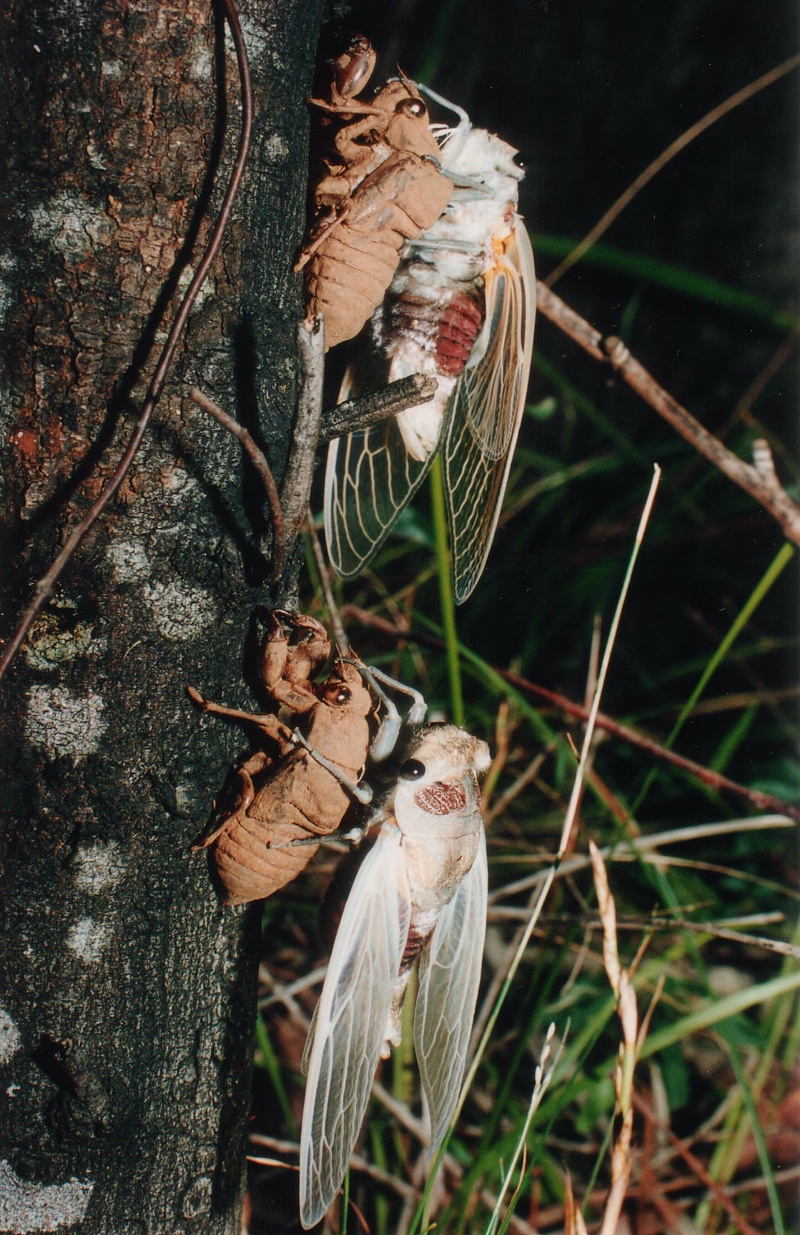I want to let you all know that Tim McNary’s Bibliography of the Cicadoidea has moved to a new URL. The new URL is http://www.tmcnary.com/CicadaBibliography.htm.
Category: Researchers
Cicada researchers associated with academic institutions.
Bagpipe Cicada
This is a photo of the amazing Bagpipe cicada (Lembeja paradoxa) was taken by Timothy Emery (David Emery’s son).
Attached is a photo taken by my son, Timothy Emery from Thursday Island, Torres Strait off Cape York, Queensland. This a male “bagpipe cicada” (Lembeja paradoxa) singing for his female. These guys at rest look like dead leaves with wings folded under stems of grass, but when singing at dusk, rush up the stems and can expand their abdomens incredibly up to 5-10 x resting size (hence the bagpipe bit) and emit a very loud droning sound for their size. A great emergence of these on Thursday Island in the first 2 weeks of January.

The Bagpipe cicada can be found in the Northern tip of Queensland, from October to February, but they’re most common during January. (Moulds, M.S.. Australian Cicadas Kennsignton: New South Wales Press, 1990, p. 178)
David Marshall and Kathy Hill have discovered that a particular species of katydid mimics the wing-flick of female cicadas to lure male cicadas to their certain doom.
We have found that predatory Chlorobalius leucoviridis katydids (Orthoptera: Tettigoniidae) can attract male cicadas (Hemiptera: Cicadidae) by imitating the species-specific wing-flick replies of sexually receptive female cicadas. This aggressive mimicry is accomplished both acoustically, with tegminal clicks, and visually, with synchronized body jerks. Remarkably, the katydids respond effectively to a variety of complex, species-specific Cicadettini songs, including songs of many cicada species that the predator has never encountered.
Read the entire research article: Versatile Aggressive Mimicry of Cicadas by an Australian Predatory Katydid.
An adult Magicicada:

A Magicicada suffering from the massospora cicadina fungus:

The fungus is spread during mating.
Another shot of the adult Magicicada:

A Magicicada suffering from the massospora cicadina fungus:

Gene Kritsky collecting a temperature probe for his cicada temperature study from Roy’s backyard:

I’m catching up on the photos Roy Troutman has sent me.
Here’s photos from a BBC photoshoot in Mariemont Ohio, taken on May 24th. The photos feature cicada expert Gene Kritsky.




The USDA National Agriculture Library has published the full 148 page bulletin from 1898 titled The periodical cicada: an account of Cicada septendecim, its natural enemies and the means of preventing its injury : together with a summary of the distribution of the different broods.
The document is viewable as images or in PDF form, and features an abundance of information, and excellent, now public domain illustrations (like those below).


Roy Troutman sent me these photos of temperature loggers that allow cicada experts, like Gene Kritsky, to measure the ground soil temperature, and improve their formulas for predicting Magicicada emergences.
We [Gene Kristsky and Roy Troutman] buried 3 temperature probes & tied one on a tree branch for air readings. The temperature loggers will take a very accurate reading every 10 minutes & after the emergence has started in full swing Gene will dig them up & hook them to a usb cable & download all the data to his laptop for study. He [Gene] is trying to determine the exact temperature that they will emerge so he can fine tune his formula for calculating emergence times.
Last year Gene’s emergence formula calculator (try it!) did a good job of predicting the Brood XIII emergence, and the 2008 temperature study should only improve it.
You might be able to participate in the 2008 cicada temperature study. If you’re interested, contact Gene Kritsky.


Diemeniana euronotiana
Here’s yet another wonderful cicada photo from David Emery in Australia: the Diemeniana euronotiana. The cicada is a mere 20mm in length, and they are now just out in the bushland around 1000m.

The Diemeniana euronotiana can be found in eastern NSW, south-eastern Victoria and Tasmania. They are most common in late November to January. (Moulds, M.S.. Australian Cicadas Kennsignton: New South Wales Press, 1990, p. 112)
Ozzie Cicadas: Emerging Thopha
Here are some emerging Thopha, Thopha saccata a.k.a. Double Drummer (I think — not 100% sure), taken by David Emery.

The many colors of the Cyclochila australasiae
I asked Dr. David Emery to explain the different colors of the Cyclochila australasiae, a.k.a. the Green Grocer, Yellow Monday, Blue Moon, Masked Devil, etc. David has allowed me to use his explanation on the site, and here it is:
Most “green” cicadas like our GG (Green grocer – Cyclochila australasiae) are coloured from the mixture of yellow and blue pigments. It is quite common for the blue to be missing to various degrees in GGs, and they exhibit shades of lighter green to yellow (even close to orange) and are then called “Yellow Mondays!”. It is also common for the blue pigment to fade in collections and so many “green” species turn a dull beige or brown. This can be fixed with a 24h soaking in 2.5-10% neutral-buffered formalin immediately after killing (or inject formalin after they die). MUCH more rarely, the yellow pigment can be missing and then we get the “Blue Moon”- love those purple eyes! In fact, having collected or spotted more than 10,000 GGs in my time, I have not caught a Blue Moon. My daughter Samantha, found the one in the photo when she was 4 years old, and another when she was 7!!
The orange-black, “masked devil” morph of the GG seems associated with altitude and these progressively appear with increasing frequency amongst GG populations above 500m in the mountains west of Sydney. For example, at Glenbrook, (elevation 150m) they are <5% of the population whereas at Hazelbrook and Blackheath (670m and 1200m, respectively), they increase to around 95% of the population. It was thought that cold underground temperatures during larval and nymphal development might also contribute, but the huge numbers of green GGs west of our ranges argue against a direct effect of temperature alone. Here the winter temps are very cold too, just as cold as the mountains. So just how these “melanisation” effects are mediated remain unresolved- one of life’s tantalizing mysteries!
Here are photos of cicadas by David Emery. Take a look.
Australian Cicada Websites
- The Chambers Wildlife Rainforest Lodges has a page of cicada facts and photos of Northern Greengrocers and a Green Baron from Tropical North Queensland.
- The AusEmade: Cicada page features cicada facts, as well as a very nice matrix of Common cicada names, their Scientific names and where they can be found. The site was just updated with Orange Drummer photos.
- The Brisbane Insects site has a selection of pages devoted to cicadas found in the Brisbane area. There are information and photos of Double Drummers, Clangers, White Drummers, Brown Bunyips, Razor Grinders, Bladder Cicadas, Floury Bakers, Thin-striped Wattles, Small Bottle, Either Bark Squeakers, and Small Bark Squeakers.
- The CSIRO site has a great list of cicadas by Scientific name; there are photos for each species, general information including where they are found.
- The Summer of Singing Cicadas page on the Scribbly Gum site is filled with excellent information including cicada names, keeping cicadas as pets, their sound, their life cycle, The Black Prince, cicada myths and where they can be found.